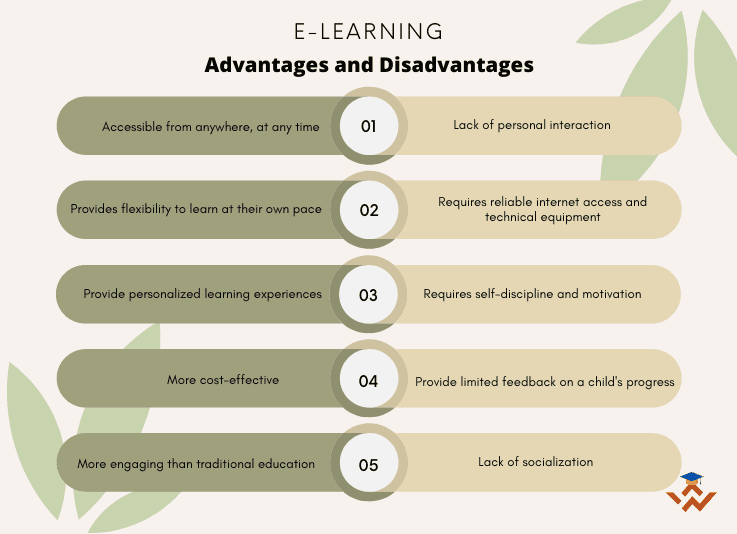Technology and digitalization have been a savior for all of us during the tough times of COVID-19. In addition to offices, schools, colleges, and universities, have also embraced technology to spread education. This is quite astounding, isn’t it?
E-learning has revolutionized the education system in India, especially in the past decade. The rapid development of technology and science has had a tremendous impact on e-learning in India. And it is expected to grow even more in the coming years with various technological advancements and innovations. Unlike traditional classroom techniques, access to information in e-learning is not limited to the teacher’s knowledge and access.
E-learning platforms have overcome this shortcoming of the traditional education system. The Indian government has taken several initiatives in the past few years to promote e-learning in India. This has led to an increase in the number of students enrolling in online courses, which is one of the most important factors driving the growth of this market. The country’s growing internet penetration and increasing awareness of e-learning are also contributing to this growth. This article will explore the future of e-learning in India in 2023-24.
What is E-learning?
E-learning is a method of learning that utilizes electronic media to present information and instruction. It is an effective way to deliver knowledge and skills in a variety of settings, including the workplace, schools, and homes.
E-learning encompasses various forms of education, such as visual classes, web-based learning, computer-based reading, digital interaction, video and audio recordings, interactive TV, and more. This makes e-learning adaptable to flexible and distance learning methods. Additionally, e-learning can be combined with face-to-face teaching to create a mixed-learning approach.
Online education allows for the storage and sharing of educational materials, including e-notes in various formats, such as films, slide shows, sentence files, and PDFs. Users can also participate in seminars (live sessions) and communicate with professors through message forums.
Advantages of E-learning
- Accessibility: E-learning can be accessed from anywhere, at any time, making it convenient for learners to access educational materials whenever they need them.
- Flexibility: E-learning allows learners to learn at their own pace and style, which can be especially helpful for those who need more time to understand a concept.
- Personalization: E-learning can provide personalized learning experiences, allowing learners to learn in a way that suits their individual needs.
- Cost-effectiveness: E-learning can be a more cost-effective way of delivering education, as it eliminates the need for physical classrooms and other resources.
- Engagement: E-learning can be more engaging than traditional classroom learning, as it often incorporates interactive elements such as videos, quizzes, and games.
Disadvantages of E-learning
- Lack of personal interaction:
E-learning can be isolating for some learners, as it does not provide the same level of personal interaction as traditional classroom learning.
- Technical issues:
Reliable internet access and technical equipment can be a challenge for some students, particularly those in rural areas.
- Self-discipline:
E-learning requires self-discipline and motivation, as students are responsible for managing their own learning.
- Limited feedback:
E-learning may provide limited feedback on student progress. Making it difficult for students to assess their own learning.
- Lack of socialization:
E-learning may not provide the same level of socialization opportunities as traditional classroom learning. This can be a disadvantage for some learners, particularly younger students.
How E-learning is Shaping the Future of India?
E-learning has been on the rise in India due to its increased accessibility, flexibility, and convenience for students. This growth can also be attributed to the rising penetration of smartphones, tablets, and laptops, the proliferation of broadband internet connections, and the increasing demand for higher education in India. It has helped bridge the gap between the quality of education in urban and rural areas, making education more accessible to all.
One significant impact of e-learning on the education system in India is the ability to personalize the learning experience. With the help of AI, VR, and AR, students can learn at their own pace and style. They can access learning content from anywhere, anytime, and learn in a more engaging and interactive manner. This has helped improve student performance, as they can learn at their own comfort level.
According to the Technavio report, K-12 blended e-learning market is expected to grow at 17.52% CAGR and will be valued at $19.59 billion by 2025.
One of the key factors driving growth in the K-12 blended e-learning market is the need for cost-effective teaching models.
The report also states that there is an increase in awareness about e-learning among students, which will lead to an increased demand for it among students.
E-learning is beneficial for both learners and teachers by addressing the issue of the student-teacher ratio in India. With the use of AI-enabled chatbots, students can receive immediate assistance, even if they do not have access to a teacher. This has improved student learning outcomes and made education more accessible to students in rural areas.
Another report from Markets and Markets states that the Indian government is investing heavily in digital education. And with the ongoing spread of COVID-19, various e-learning schemes have been introduced to counterbalance the education sector.
Government initiatives like Digital India, Digital University, and Make in India are expected to boost this market further. There are several government programs for under- and postgraduate students, such as DIKSHA and SHAGUN, which have gained enormous popularity throughout the country.
In addition, Indian universities are collaborating with foreign universities to offer online courses. And international corporations are also partnering with local players to localize their products, which is positively contributing to market growth. This will lead to a surge in the number of high-quality, high-demand jobs in this area, providing a significant chance for young professionals to invest in their careers.
Furthermore, the e-learning market in India is growing at a CAGR of 16.8% by 2020 and will grow at 27.6% by 2025. These numbers show how India is rapidly progressing into the digital era.
Challenges in Implementing E-learning in India
While e-learning has the potential to revolutionize the education system in India, there are several challenges in implementing it effectively. One of the primary challenges is the lack of infrastructure and resources in many parts of the country. Many schools and colleges in rural areas do not have access to the internet, computers, or other technological resources required for e-learning.
Another challenge is the lack of trained teachers and technical support staff. E-learning requires specialized skills and knowledge, and many teachers and staff members may not have the necessary training to implement it effectively. This can lead to a lack of quality in the e-learning experience, which can impact student learning outcomes.
Moreover, the Digital divide in India affects students’ access to e-learning and widens socio-economic disparities.
The Future of E-Learning in India
Despite the challenges, the future of e-learning in India looks promising. Tech growth and government support will boost e-learning’s future prevalence. The government’s Digital India campaign promotes digital literacy and rural tech accessibility.
E-learning is a mode of learning that targets the needs of many learners and can be accessed at any time, anywhere. Interactive worksheets, educational videos, live sessions, blogs, and tutorials are all part of e-learning. It provides an excellent opportunity to create more sustainable futures.
The government of India now requires schools in India to adopt an online curriculum starting in 2022-23, accelerating the growth of the online learning market. More students are signing up for online courses, making the market bigger. The number of people using the internet in India is increasing. Indians are learning more about e-learning, which also helps the market grow. The future of e-learning in India looks great because of new technologies like AI, VR, AR, gamification, microlearning, and mobile learning.
The e-learning system helps children gain insight into their respective subjects and promotes the development and inclusion of their learning experience. A widely adopted e-learning program would be better if it flourished globally. It is only possible if everyone is aware of how to find the resources provided. In a recent report, universities in India are adopting e-learning to reduce their environmental impact. It helped them reduce the number of books on campus by 50% and go digital. Besides reducing the space required to store books, this also saves electricity and water.
Moreover, several private players have entered the e-learning market in India, providing innovative solutions to the challenges faced in implementing e-learning. Companies like Khan Academy, Byju’s, and Vedantu are using AI, VR, and AR to create immersive and interactive learning experiences.
Conclusion
E-learning has become a fundamental need in the Indian education sector. Despite the economic crisis, children are still pursuing their studies and learning with the help of e-learning. This system has made education more tech-savvy and ensures that each individual receives the attention they deserve. In developing countries like India, resources such as uniforms, fees, and educational materials are scarce. E-learning steps in as a savior in such situations.
Like the article? Let us know your thoughts in the comments.






This Post Has 2 Comments
great experience
Thanks, Anu. We hope that you liked our blog. Stay tuned!! we are coming up with more informative blogs in upcoming weeks.